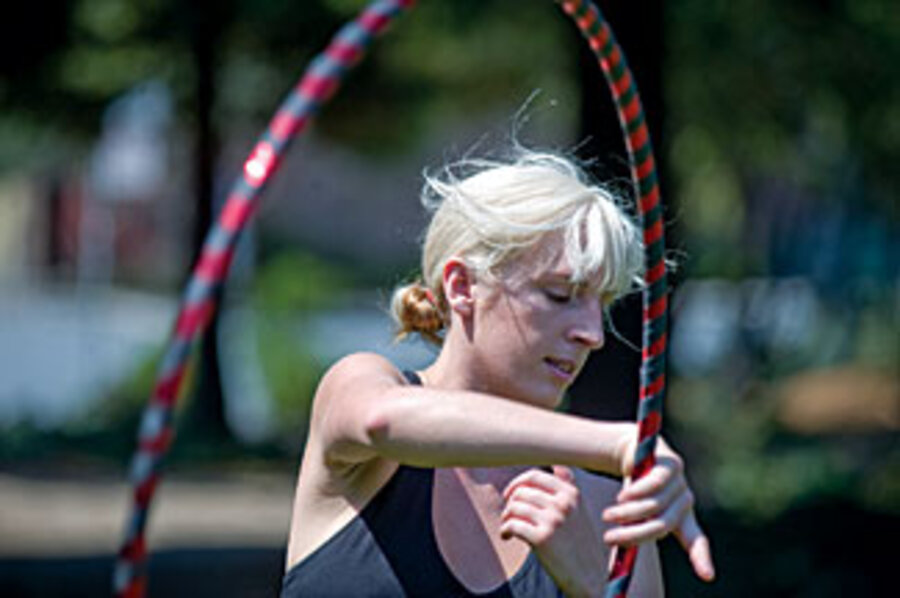A new fitness craze – Hula Hooping?
Loading...
| San Francisco
It's a common sight in San Francisco – the green grass of a neighborhood park is accented by brightly colored hoops twirling at improbable angles around people grooving stylishly to dance music under the afternoon sun.
These are the Bay Area Hoopers, who meet every Sunday afternoon in parks around the city to practice their moves, holding the hoops aloft, then spinning them around their midsections, arms, shoulders, and legs.
For Philo Hagen, cofounder of the Bay Area Hoopers and editor of Hooping.org, the hoop is a way to shift one's attention from the head to the rest of the body. He says hooping is fun, childlike, and meditative, all of which make it tremendously good for the spirit.
"It's hard to get caught up in anything too seriously when you're hooping, and it's pretty guaranteed to put a smile on your face," Mr. Hagen says.
Most commonly known as an outmoded childhood toy, the Hula Hoop has gone from being a 1950s fad to 21st-century fitness trend. Outdoor hooping groups have emerged across the country, and structured indoor classes are increasingly offered at fitness centers.
But Hula Hooping, or hooping, for those using larger, often homemade hoops rather than those patented by Wham-O, is to many enthusiasts more than just a fun form of exercise. Participants talk of improved self-esteem, revived social lives, and even lighter spirits as they learn to take basic hoop-swirling to the next level.
Hula Hooping, named after the Hawaiian hula dance, was made popular in the 1950s when Australian businessman Alex Tolmer started selling plastic hoops at his department store, Toltoys, according to the Encyclopædia Britannica.
Wham-O bought the American rights to the toy and introduced the Hula Hoop into the southern California market in 1958, after which an estimated 100 million hoops sold in just two years, according to Britannica.
The hoop came back for a time in the '80s, but this decade has seen the toy become part of an innovative workout trend combining fitness and dance.
Since Hagen started Bay Area Hoopers spontaneously with a friend in 2003, the group has gained hundreds of members, and a regular crew gathers each week. Early on, hoopers noticed that they were getting in great physical shape, and the fitness angle caught on quickly.
"We were just hooping for fun," he says, "and what we found was people were like, 'You're looking great!' "
Hagen lost a clothing size, and he says others have lost as much as 30 pounds.
Hooping can burn up to 600 calories an hour, according to hooping guru Christabel Zamor.
This was Ms. Zamor's experience; she went from being a shy, heavyset graduate student to a svelte fitness instructor and entrepreneur as a result of taking up hooping as a hobby in 2001, she says. She started practicing in the park once a week and soon found that it became one of the things she most looked forward to.
"I just felt so free and uninhibited, and I hadn't realized how uptight I had been," she says. "The more I hooped, the more lighthearted and easygoing I got."
Over time, more people started coming to Zamor's weekly hooping sessions in San Francisco. She developed classes and performances, eventually leaving her doctoral program in cultural anthropology and taking up hooping full time.
Since then, Zamor, founder and CEO of HoopGirl Inc., has become a key proponent of the new exercise trend. These days, she's seems positively aglow with success – HoopGirl is rapidly expanding, with an array of classes; performances; teacher certification programs; workout videos like "Hoopdance Evolution"; and a new book, "Hooping: A Revolutionary Fitness Program." The company now has more than 350 certified instructors in 12 countries.
For Sally Estrada of San Francisco, who was at the city's Esprit Park with the Bay Area Hoopers on an August Sunday, hooping is one of the best workouts she's found. A former personal trainer, she sees it as one of the most effective ways to strengthen "the core."
"It's very tone-building but it doesn't make you big because you're not lifting big weights," she says.
Julie Greicius of Palo Alto, Calif., joined in after seeing a woman hooping to DJ music last fall in front of a famous record store in San Francisco. She started taking classes and became a licensed teacher through HoopGirl. Ms. Greicius now takes her children, ages 11 and 6, out to the park several times a week and brings about 10 hoops for people in the neighborhood to use.
"There's a real community feel about it," Greicius says. "You might see people hooping alone, but not often."
Hooping has come a long way since its widespread popularity in the 1950s, as it has moved from being a toy to being a dance and exercise aid.
As Hagen says, "these are not your grandmother's Hula Hoops."•






